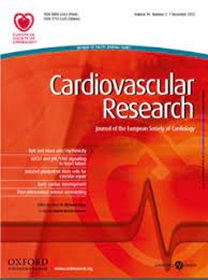心肌能量代谢研究进展:心力衰竭及其后的代谢重塑
IF 10.2
1区 医学
Q1 CARDIAC & CARDIOVASCULAR SYSTEMS
引用次数: 0
摘要
心脏的高能量需求主要由线粒体氧化磷酸化产生的 ATP 来满足,糖酵解产生的 ATP 量较少。心力衰竭时,这种 ATP 的产生会发生明显变化,主要是由于线粒体氧化代谢的减少。虽然糖酵解 ATP 生成的增加部分弥补了线粒体 ATP 生成的减少,但衰竭的心脏仍面临能量不足的问题,这也是导致收缩功能障碍的严重原因。在衰竭心脏中,不同燃料对线粒体产生 ATP 的相对贡献发生了显著变化,这在很大程度上取决于心衰的类型。各种类型心衰(包括高频心衰、高频心衰和糖尿病心肌病)的一个共同代谢缺陷是线粒体氧化葡萄糖产生的丙酮酸(即葡萄糖氧化)减少。无论糖酵解是否增加,葡萄糖氧化都会减少,导致糖酵解与葡萄糖氧化脱钩,从而降低心脏效率。心脏线粒体对脂肪酸的氧化会增加或减少,这取决于心衰的类型。例如,高频心力衰竭和糖尿病心肌病患者的心肌脂肪酸氧化增加,而高频心力衰竭患者的心肌脂肪酸氧化减少或保持不变。酮体的氧化(为衰竭的心脏提供重要的能量来源)也因心衰类型的不同而不同,HFrEF 的酮体氧化增加,而 HFpEF 和糖尿病心肌病的酮体氧化减少。衰竭心脏线粒体氧化代谢和糖酵解的改变是由于参与代谢途径的关键酶的转录变化,以及能量代谢酶的氧化还原状态、代谢信号转导和翻译后表观遗传变化的改变造成的。重要的是,靶向线粒体能量代谢途径已成为改善衰竭心脏的心功能和心脏效率的一种新型治疗方法。本文章由计算机程序翻译,如有差异,请以英文原文为准。
Advances in myocardial energy metabolism: metabolic remodeling in heart failure and beyond
The very high energy demand of the heart is primarily met by ATP production from mitochondrial oxidative phosphorylation, with glycolysis providing a smaller amount of ATP production. This ATP production is markedly altered in heart failure, primarily due to a decrease in mitochondrial oxidative metabolism. Although an increase in glycolytic ATP production partly compensates for the decrease in mitochondrial ATP production, the failing heart faces an energy deficit, that contributes to the severity of contractile dysfunction. The relative contribution of the different fuels for mitochondrial ATP production dramatically changes in the failing heart, which depends to a large extent on the type of heart failure. A common metabolic defect in all forms of heart failure (including HFrEF, HFpEF, and diabetic cardiomyopathies) is a decrease in mitochondrial oxidation of pyruvate originating from glucose (i.e. glucose oxidation). This decrease in glucose oxidation occurs regardless of whether glycolysis is increased, resulting in an uncoupling of glycolysis from glucose oxidation that can decrease cardiac efficiency. The mitochondrial oxidation of fatty acids by the heart increases or decreases, depending on the type of heart failure. For instance, in HFpEF and diabetic cardiomyopathies myocardial fatty acid oxidation increases, while in HFrEF myocardial fatty acid oxidation either decreases or remains unchanged. The oxidation of ketones (which provides the failing heart with an important energy source) also differs depending on the type of heart failure, being increased in HFrEF, and decreased in HFpEF and diabetic cardiomyopathies. The alterations in mitochondrial oxidative metabolism and glycolysis in the failing heart are due to transcriptional changes in key enzymes involved in the metabolic pathways, as well as alterations in redox state, metabolic signaling, and posttranslational epigenetic changes in energy metabolic enzymes. Of importance, targeting the mitochondrial energy metabolic pathways has emerged as a novel therapeutic approach to improving cardiac function and cardiac efficiency in the failing heart.
求助全文
通过发布文献求助,成功后即可免费获取论文全文。
去求助
来源期刊

Cardiovascular Research
医学-心血管系统
CiteScore
21.50
自引率
3.70%
发文量
547
审稿时长
1 months
期刊介绍:
Cardiovascular Research
Journal Overview:
International journal of the European Society of Cardiology
Focuses on basic and translational research in cardiology and cardiovascular biology
Aims to enhance insight into cardiovascular disease mechanisms and innovation prospects
Submission Criteria:
Welcomes papers covering molecular, sub-cellular, cellular, organ, and organism levels
Accepts clinical proof-of-concept and translational studies
Manuscripts expected to provide significant contribution to cardiovascular biology and diseases
 求助内容:
求助内容: 应助结果提醒方式:
应助结果提醒方式:


